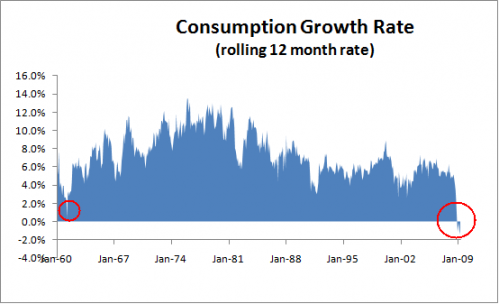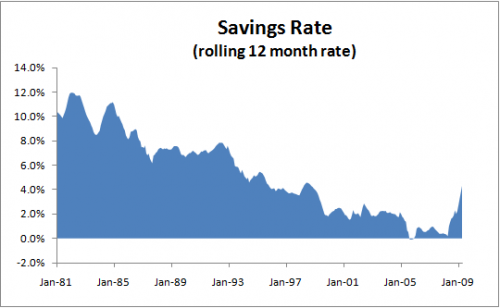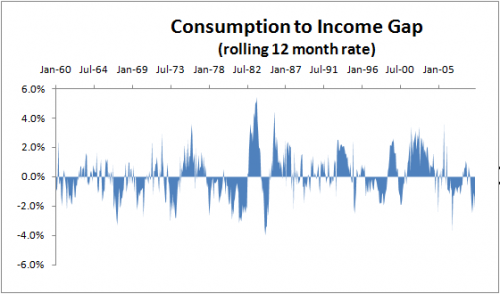Why the personal consumption data is important to the stock market
The data for personal consumption came out yesterday. However, I have not had a chance to look at the data and write a post until now. What I see right now is not good for a sustainable recovery. Let me tell you why and how this could impact the chances for getting a longer cyclical bull market.
Every month, the Bureau of Economic Analysis (BEA) releases a data series called Personal Income and Its Disposition. This measures personal income received by Americans and how this money is either spent or saved. If the increase in income is good, generally that will flow through to consumption and ultimately increase retail sales and GDP.
Last year, as the recession took hold and commodity prices soared the real growth in personal income turned negative. That is to say the amount of money people earned adjusted for inflation was lower than it had been just 12 months prior. This trend began in January 2008, just after the recession began. Since Americans were earning less in aggregate (due mainly to inflation and job losses), they were spending less. I like to look at the 6-month average real personal consumption expenditures (PCE) number as a proxy for the trend in American spending habits. I compare this average to the average just 12-months prior to see if consumption is trending up or trending down.
Clearly, consumption in the United States is trending down. In fact, the average real PCE has never been negative in the studies 50 years until March 2009. Only in the early 1960s did it flirt with negative territory. It now stands at –0.7%. Translation: Americans are spending less. This is true for two reasons. First, many are losing their jobs. Therefore, personal income is under stress. But, Americans are also saving more. The savings rate hit 5.7% in April, the highest rate since 1995.
If you buy into Richard Koo’s balance sheet recession idea which I presented to you earlier today (see Central banks will face a Scylla and Charybdis flation challenge for years), then you should expect the savings rate to continue to march higher as consumers focus on debt reduction at the expense of consumption.
Going forward, I will be looking to highlight a statistic I follow which gets to the heart of this which I will call the Consumption to Income Gap (CIG). This statistic identifies when the rate of growth of consumption lags or leads the rate of growth of income.
In the past 50 years, the CIG turning negative has signalled impending economic weakness because the flow of causation is income to consumer spending to production to capital spending to GDP 9see my post “The Economy’s Four Horsemen” for more on that topic). But, the CIG tends to turns positive when the economy is improving and consumers no longer feel threatened.
Now, if Richard Koo is right that we are poised for a longer-term ‘balance sheet recession,’ the CIG will stay negative for a long time and the savings rate will continue to increase. At present, this certainly what is occurring (since September 2008). However, 2001 presented a mirror image of this phenomenon. After the recession of 2001, the CIG stayed positive throughout the recession due to unprecedented monetary easing and deficit-inducing fiscal stimulus by George W. Bush. Every month showed consumption growth in excess of income growth from April 2001 when the recession actually began until July 2004, a full 32 months after the recession had ended.
When the CIG turned solidly negative in January 2006, you could have seen this as a sign of economic weakness and a harbinger of the recession which eventually came in December 2007.
My view on how to view this statistic is this: if the CIG continues in negative territory, look to the first outcome I outlined in Central banks will face a Scylla and Charybdis flation challenge for years as the likely scenario to expect. However, if the CIG turns positive, this would mean the reflation trade has gained traction and scenario #2 would be the likely outcome.
In terms of the rally in shares now ongoing, scenario #2 is bullish for the period after 2009 because it means the economy will be supported by ‘excess’ consumption. On the other hand, scenario #1 is not bullish because it will mean a weak economy and a potential double-dip.
Watch the Consumption-to-Income Gap. I think it will be an important statistic to follow in terms of gauging where consumer spending is headed and what impact that will have on retail sales, company profits and stock prices.



Great post Ed.
hi Ed, thanks for the last 2 posts on Richard Koo. You’re one of the few I’ve seen who have highlighted his work. I recently finished Holy Grail, which you cited, and was quite taken by his analysis (really like how he synthesises the fiscal-monetary debate). However:
(i) I thought he skimmed over the Jap banking problem too quickly, by attributing the problems entirely to lack of demand for funds, without addressing to what extent a zombie banking sector held back recovery (except for a bit of data showing low bank interest rates and anemic loan growth even among foreign banks, which theoretically could have stepped in to fill the gap left by zombie dom banks if loan demand had been strong). (ii) Also, I was disturbed by his conclusion that the best thing the govt can do is borrow like mad, to replace corporate/household borrowing. Its certainly coming back to haunt Japan now, with debt at nearly 200% of GDP.
(iii) finally i’m not sure how applicable the Jap policy measures are to the US now (though i think the analysis is applicable), as Koo argues that it was corp BS that got destroyed in Japan, while Jap households were able to draw down past years of savings to keep up consumption. In the US its households that have horrible BS, I’m not so sure about corporates.
I’m just wondering what you think of these points, and how much you agree with Koo’s analysis, because I haven’t seen much discussion of his work. (or perhaps I’m not looking in the right places.)
matthew